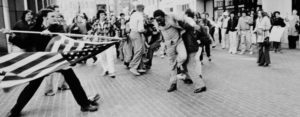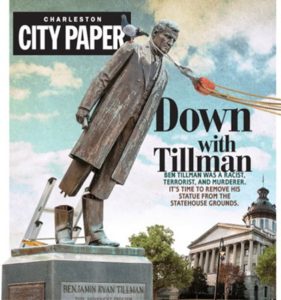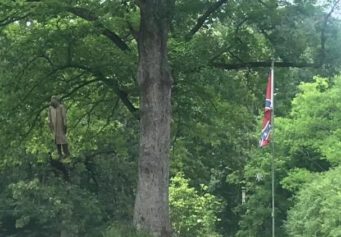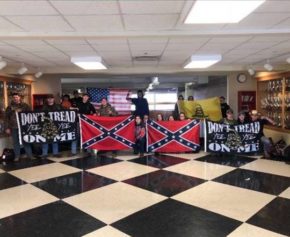
Theodore Landsmark, a black Boston attorney, was attacked and threatened with a steel-shafted flagpole by a gang of white youths protesting integration of Boston schools in 1976. Photo by 1980 Nieman Fellow Stanley Forman for the Boston Herald American.
By Gus T. Renegade
Do not adjust your screen. That is not the Confederate flag. In 1976, Black attorney Ted Landsmark was speared with the other red, white and blue flag in Boston. Racist rage over school desegregation and busing impaled Landsmark. These white Bostonians harbored anxieties similar to those attributed to suspected South Carolina killer Dylann Storm Roof. Both parties loathed the prospect of Black children being educated alongside whites and rejected nonviolence.
But no one blamed the Boston assault on Old Glory. The Confederate flag has been less fortunate.
After failures to indict the white killers of Eric Garner, Michael Brown Jr., John Crawford III and untold Black victims, the secessionist battle flag is a convicted racist. For the first time in history, a flagpole is under the bus.
Mitt Romney, South Carolina Gov. Nikki Haley, South Carolina State Rep. Doug Brannon and a host of “well-meaning” whites have made the Confederate flag an accomplice in the Mother Emanuel AME massacre. This insulting façade obscures the pathology of white culture, which guarantees the production of Dylan Storm Roofs and complementary white power paraphernalia.
To remove the Confederate flag from the South Carolina state house would require walking past the monument to former governor, United States senator, co-founder of Clemson University and “anti-Black terrorist” Benjamin “Pitchfork” Tillman. Cynthia R. Greenlee describes Tillman as one of Roof’s “spiritual ancestors,” who was equally unhinged about the prospect of “Black men and white women in ‘sexual congress.’” In a 1909 speech, Tillman makes his views crystal clear, pledging support for “terrorizing the Negroes at the first opportunity by letting them provoke trouble and then having the whites demonstrate their superiority by killing as many of them as was justifiable.”
Tillman’s white supremacist vision is cherished and protected throughout the Palmetto State. Campaigns to remove his statue and rename buildings brandishing his name on the campuses of Winthrop University and Clemson were categorically defeated earlier this year. The shrines and legacy of “Pitchfork” Ben remain secure and above culpability for the Emanuel 9 slaughter.
Tillman’s political ancestors, Gov. Haley and State Sen. Paul Thurmond, charge that for some, the Confederate battle flag represents a “symbol of war, hate and divisiveness.” But the senator’s surname, the South Carolina landscape and world history leech any possible sincerity from these charges. The senator’s father, Strom Thurmond, is a kindred spirit of the South Carolina gunman; Strom Thurmond devoted nearly a half-century to the U.S. Senate in service of white power. The elder Thurmond also earned a monument at the State Capitol, which has escaped condemnation and calls to be scrapped.
The white hue and cry targeting the flag has also omitted The Citadel. Emanuel AME pastor and State Sen. the Rev. Clementa Pinckney discussed the history and formation of the South Carolina military academy: “The [Citadel] guns were pointed in the direction of where the members of Mother Emanuel lived. Just in case there was another [Black] insurrection, the state was ready.” The research of historian and author David Robertson substantiates Pinckney. Robertson documents that The Citadel was purposely constructed as an institutional force to “protect the white citizens against” Black liberation.
Evidence that the academy has sustained allegiance to its anti-Black foundation points to the rejection of Black cadets until 1966. A bestselling book and major motion picture, The Lords of Discipline, are allegedly based on the horrors of a Black cadet who “was tortured by a white-supremacist group.”
In 1992, Rick Reilly penned a comprehensive, contested report on the academy. His essay suggests The Citadel would be a comfortable, familiar environment for Dylann Storm Roof. Reilly writes:
“In 1986 five white cadets went into the bunk room of black freshman Kevin Nesmith, the brother of the only black member of the board of visitors. Wearing sheets – and pillowcases over their heads – and holding a burning paper cross, they mumbled Nesmith’s name and uttered racial obscenities. Today all five of his assailants wear the Citadel ring.”
Reilly cites a 1988 planning report, which “found that 56% of black cadets… said they were discriminated against ‘because of their race.’” During the early ’90s, The Citadel convened a study of “race relations” on campus. They “recommended that the playing of Dixie and the waving of Confederate flags at football games be discouraged.” Not prohibited. To demonstrate the union between The Citadel, the Confederate flag and white pride, Reilly offered this anecdote:
“At a Friday lunch last year a senior announced the Senior of the Week award. It went to the cadet who had climbed 700 feet up the Channel 2 tower in Charleston to hang the Confederate flag. Cheers rocked the mess hall…”
It’s effortless to envision Roof in the raucous crowd.
Incidentally, it’s widely acknowledged that the military college of Francis Underwood, Kevin Spacey’s character on the Netflix smash, House of Cards, is the television version of The Citadel.
Will Mitt Romney, Sen. Brannon and the white folks who’ve denounced the racist symbolism of the Confederate flag provide an equal rebuke of The Citadel?
Or South Carolina’s J. Marion Sims?
Former president of the American Medical Association and “father of modern gynecology,” Sims and Roof are simpatico in their appraisal of Black life. Harriet A. Washington’s seminal publication, Medical Apartheid, records how his “vigorous defense of the slavery system had been liberally seasoned with ‘n-gger.’” Washington reveals Sims’ “penchant for taking shoemakers’ tools to Black infants’ skulls.” Roof’s forefather “bought Black women slaves and addicted them to morphine in order to perform dozens of exquisitely painful, distressingly intimate vaginal surgeries.”
The S.C. State Capitol deemed Sims worthy of a memorial.
But white supremacy is not singularly Roof or South Carolina. Sims has monuments in Alabama and Central Park in New York because white domination and contempt for Black life are dominant global concepts. France Winddance Twine submits that we are inundated with sanctified markers of racial terror and white power. Many of these symbols are unabashedly adored because of their connection to anti-Blackness and white rule.
Earlier this year, President Barack Obama, global dignitaries and a hoard of good white folks celebrated the 50-year anniversary of the sadistic beating of Black demonstrators in Alabama. Many are aware that “Bloody Sunday” occurred on Selma’s Edmund Pettus Bridge. Apparently, a significant number of Selma natives are unaware that this “hallowed” structure is named after “the head of the most notorious white terrorist group in Alabama probably up until the civil rights movement.” University of Alabama historian John Giggie confirms that this bridge – constructed in 1940 – is one of countless edifices, flags and icons unabashedly dedicated to white power. Whites in Selma calculated to broadcast a naked, flagrant signal: “They wanted to stamp that [bridge] with this vision of the South as very much as… a world dedicated to white supremacy.”
Jack Townes is a Selma native, 21, and Black. After discovering the namesake of the bridge, Townes and a group of activists labored to rename the structure.
Pardon the redundancy.
They failed. Edmund Pettus Bridge remains because the manifesto attributed to Roof states correctly that, “Blacks are subconsciously viewed by white people [as] lower beings.” Which necessitates a world dedicated to white supremacy. It’s insulting to reduce a concept that has ruled and contaminated this planet for centuries to a 21-year-old white boy and a glorified stitch of cloth.
North Carolina NAACP President the Rev. Dr. William Barber denounced the Confederate flag as vulgar, but added that, “To suggest… taking a symbol down is sufficient to honor nine deaths… is to diminish those lives.” The Rev. Barber recognizes 2015 anti-Black policies and practices that are far more hazardous than Civil War memorabilia. Discarding the Confederate flag leaves contemporary mechanisms of racism intact.
Flags don’t produce racism. White thoughts, speech and actions nourish and maintain white power. The removal of apartheid statues and “whites only” signs demonstrates that white people can efficiently preserve the systemic exploitation of Black people without blatant markers. It’s unlikely a South Carolina void of Confederate flags would have preserved and valued the lives of shooting victim Walter Scott or the Emanuel 9.
Dylann Roof is not a Confederate killer. He and Chris Kyle are American snipers, the most recent generation of white killers. At minimum, this tragedy should permanently clarify our grasp of white pathology and heighten our suspicion of all white folks. Even, those like Kyle, who insist that, “Americans [respect] houses of worship as sacred and therefore [are] reluctant to attack there.”
Gus T. Renegade is the host of The C.O.W.S. Talk Radio – a platform designed to dissect and counter racism. He has interviewed and researched authors, filmmakers and scholars from around the globe.
[playwirevid id=’3690684′]



